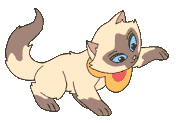



 |
 |
 |
 |
 |
||
| Special Update: How to Talk With Your Kids About the Recent Events |
||
 |
Sagwa, The Chinese Siamese Cat is a new PBS animated adventure designed for 5 to 8-year-olds. Set against the backdrop of ancient China, Sagwa displays the boundless energy and fresh perspective of an 8-year-old discovering the world and learning some of life's most important lessons. Based on the childrens book, Sagwa, The Chinese Siamese Cat, by acclaimed author Amy Tan, each episode features two 11-minute animated adventures. It also features a mini-documentary in which real children share their hobbies, music, special festivals, foods, and show off their neighborhoods. Through this combination of adventure and documentary, children explore both the culture of China long ago as well as the cultures of children around the world today. Storytelling has long been used as a means of helping children understand and deal with the often difficult issues they face in their daily lives. Sagwa uses this timeless vehicle to bridge the gap between the context in which its stories are set and contemporary issues and challenges that children face today. By employing a setting that is different from the one in which most children live, Sagwa highlights both the differences and similarities that exist across cultures. The heart of Sagwa Who am I? How do I get along with others? What does it mean to be honest? How can I stand up for what I believe in? What are my responsibilities? What does it mean to be open-minded and tolerant? What is it like to be gaining more independence? Sagwa addresses such questions at the heart of growing up by: a) Modeling strategies for dealing with the personal and social issues children face as they grow into a variety of new roles. b) Exposing children to elements of cultures other than their own and showing that children all over share many of the same interests and emotions. Why is the series beneficial to children? Through Sagwa's humorous adventures and the mini-documentaries, children enter the culture of China long ago and the cultures of children all over the world today. Discovering the similarities and differences they share with others sparks children's interest and appreciation of a wider world. While enjoying the cats' adventures in a beautiful, far-off land, children learn strategies for dealing with their fears, telling the truth in difficult situations, standing up for what they believe in, making friends and dealing with peer pressure, and many other challenges children face as they grow up. How can I use the show with children? You can help children get the most from Sagwa by: * Encouraging children to talk about the stories and relate them to their own experiences. * Talking about whether the solutions to problems seem realistic or not. * Reading stories that deal with the same themes that appear on the series. (See the Suggested Reading list below.) * Using Sagwa to launch storytelling activities, including writing, telling, illustrating, and acting out classic tales, real-life stories, and original stories. * Engaging children in sharing stories and information about different cultures. |
|
Here are some good books related to Sagwa's goals and themes, and characters.
Appreciating Differences
Consequences
Family
Friendship
Honesty
Making Choices
Overcoming Fears
Perseverance
Recognizing and appreciating what you have
Standing up for what you believe in/Believing in yourself
Animals, Pets, and Mythical Creatures
Children and Adventures Around the World
|
||
HOME | PBS Kids
Games | Stories | Color &
Draw | Characters | TV Sneak Peek | Making the Show | Caregivers Area
Based on the book "The Chinese Siamese Cat," written by Amy Tan with illustrations by Gretchen Schields.
© 2001-2003 CinéGroupe Sagwa Inc. Characters and Original Story © 1994 Amy Tan. Illustrations © 1994 Gretchen Schields.
"Sagwa" and its logo are trademarks of CinéGroupe Sagwa Inc. All rights reserved.